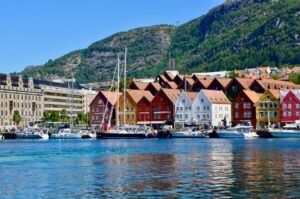

Express Gratitude: Learn Norwegian for Thank You
Gratitude is a universal language that unites us all. In Norway, expressing appreciation is deeply ingrained in the culture, and learning how to say “thank you” in Norwegian is a beautiful way to connect with the locals.
In this section, we will explore the significance of expressing gratitude and delve into Norwegian culture’s unique traditions and customs related to appreciation. We’ll learn how to say thank you in Norwegian, along with other common phrases that convey thankfulness
Table of Contents
ToggleKey Takeaways:
- Expressing gratitude is a universal language that connects people worldwide.
- Norwegian culture places great importance on expressing appreciation.
- Learning how to say thank you in Norwegian is a beautiful way to connect with the locals.
- Knowing how to express gratitude goes beyond language; it improves our relationships and overall happiness.
- Learning Norwegian phrases for thank you is just the beginning of incorporating gratitude into our daily lives.
The Importance of Gratitude
In a world where material possessions and achievements often take center stage, it can be easy to overlook something as simple as expressing gratitude. However, the benefits of gratitude cannot be ignored. Not only does acknowledging the things we’re thankful for help us appreciate what we have, but it can also lead to increased feelings of happiness, improved relationships with others, and reduced stress levels.
Additionally, expressing appreciation can have a positive impact in various aspects of our lives. In the workplace, showing gratitude towards colleagues or employees can lead to increased motivation and productivity. In personal relationships, regularly expressing gratitude towards a partner can strengthen the bond between you.
Overall, incorporating practices of thankfulness and expressing appreciation can enrich our lives and lead to a more fulfilling existence.
Norwegian Culture and Gratitude
Norwegian culture places tremendous importance on gratitude and expressing appreciation. It is deeply ingrained in their traditions and customs. Understanding these cultural aspects helps in appreciating the real meaning of saying thank you in Norwegian.
Gratitude in Daily Life
In Norway, showing gratitude is a part of everyday life. It is common to thank people for even the smallest of things, like holding the door open or passing something to someone. Norwegians often use the phrase “takk for det” to express their gratitude.
Special Occasions
Norwegians have many special occasions to express gratitude, including Christmas and birthdays. During these times, Norwegians exchange gifts and express their appreciation for each other.
| Occasion | Traditions |
|---|---|
| Christmas | Gift-giving, family gatherings, indulging in traditional foods |
| Birthday | Serving cake with lit candles, singing the birthday song, giving gifts |
Thank You Notes
Thank you notes are a common practice in Norway, especially in business settings. It is customary to send a handwritten note to express gratitude for any acts of kindness or help received. It is also common to include a small token of appreciation like flowers or chocolates.
In summary, expressing gratitude is an integral part of Norwegian culture, and learning how to say thank you in Norwegian helps in understanding the essence of their culture.
Learning Norwegian for Thank You
Learning how to say “thank you” in Norwegian is not only a polite gesture but also an excellent way to explore the language and culture of Norway. The Norwegian language has several ways of expressing gratitude, from formal settings to casual conversations.
| Phrase | Pronunciation | Translation | Usage |
|---|---|---|---|
| Takk | tahk | Thank you | The most common way of expressing gratitude in any situation |
| Tusen takk | too-sehn tahk | Many thanks | Used to express immense gratitude or appreciation |
| Takk skal du ha | tahk skahl doo hah | Thank you very much | A formal way of expressing gratitude in formal settings |
These phrases are just the beginning of exploring the language of gratitude in Norwegian. Other common expressions include “takk for sist” (thank you for the last time we met) and “takk for maten” (thank you for the meal).
By learning these phrases, you can show your appreciation to Norwegians you meet and even enhance your travel experience. Using these expressions helps create positive relationships and makes you feel more confident when interacting with locals.
Incorporating Gratitude in Everyday Life
Learning Norwegian for thank you is just one way to incorporate gratitude into our lives. It’s essential to make expressing gratitude a daily habit. Here are some practices of thankfulness and ways to integrate gratitude into your daily routine:
- Start a gratitude journal: Write down three things you’re thankful for each day.
- Focus on the positive: Instead of complaining about what you don’t have, focus on what you do have.
- Practice mindfulness: Take a few minutes each day to sit quietly and focus on the present moment.
- Show kindness: Perform random acts of kindness for others, such as holding the door or buying someone a cup of coffee.
- Express your appreciation: Make a conscious effort to thank the people in your life who have helped you or made a positive impact.
By incorporating gratitude into our daily lives, we can improve our well-being, relationships, and overall happiness. So take a moment each day to reflect on what you’re thankful for and express your appreciation to those around you.
Conclusion
Learning Norwegian for thank you is a gateway to Norwegian culture and traditions. Incorporating gratitude into our lives can have a profound impact on our well-being and happiness. By recognizing the importance of expressing appreciation and making gratitude a part of our daily routine, we can enjoy stronger relationships and a more fulfilling life.
Expressing gratitude is deeply woven into the fabric of Norway’s culture. From their unique traditions to their language, Norwegian society places a great emphasis on appreciation and thankfulness. By learning how to say thank you in Norwegian, we can gain a deeper understanding and appreciation for their culture.
Final thoughts reveal that learning and practicing gratitude is a small step towards leading a happier life. Let’s take inspiration from Norway and incorporate practices of thankfulness in our daily routine to express gratitude for everything around us.
FAQ
Can learning how to say thank you in Norwegian improve my relationships?
Yes, expressing gratitude in any language can strengthen relationships by showing appreciation and fostering a sense of connection.
Are there different ways to say thank you in Norwegian?
Yes, Norwegian offers various options to express gratitude, such as “takk,” “tusen takk,” and “takk skal du ha,” each carrying different levels of gratitude.
Are there specific situations where certain thank you phrases are used in Norwegian?
Absolutely! Norwegians have specific phrases for different situations, like “tusen takk for hjelpen” (thank you for the help) or “takk for en koselig kveld” (thank you for a lovely evening).
Can I use these common Norwegian phrases to express gratitude in writing?
Yes, these phrases are equally suitable for verbal and written expressions of gratitude, allowing you to convey your thankfulness in any situation.
How can I incorporate gratitude into my daily routine?
There are various ways to do so. Keeping a gratitude journal, taking a moment each day to reflect on what you’re grateful for, and practicing random acts of kindness are all effective ways to incorporate gratitude into your daily life.
Is gratitude valued in Norwegian culture?
Absolutely! Norwegian culture places great importance on gratitude and expressions of appreciation. Learning how to say thank you in Norwegian allows you to connect with the cultural values and traditions of Norway.
If you want to learn Norwegian, you can register for classes here. We look forward to hearing from you and helping you become fluent in Norwegian.





